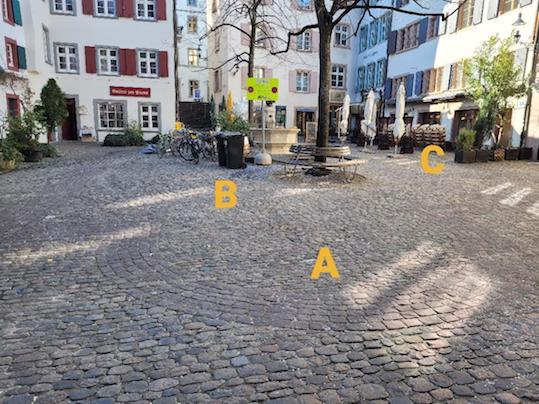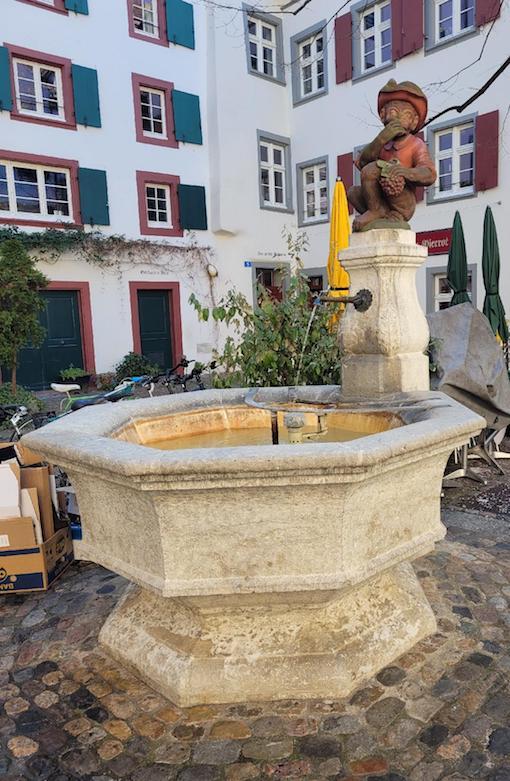Andreasplatz - Andreaskapelle - Affenbrunnen Virtual Cache
Andreasplatz - Andreaskapelle - Affenbrunnen
-
Difficulty:
-

-
Terrain:
-

Size:  (virtual)
(virtual)
Please note Use of geocaching.com services is subject to the terms and conditions
in our disclaimer.
English version below
Der Andreasplatz
Der Andreasplatz ist eine kleine Oase mitten in der Stadt und lädt zum gemütlichen Verweilen und Ausruhen ein.
Einst stand hier eine Kirche. Nach dem Zweiten Weltkrieg musste der Platz sogar um seine Zukunft bangen. 1949 wurde der „Korrektionsplan Grossbasel“ vom Volk angenommen. Ein Plan, den die Basler Regierung nach dem zweiten Weltkrieg zum Entgegenwirken des grossen Verkehrsauf-kommen lancierte. Der Marktplatz wäre als Verkehrsscheibe genutzt worden. Der Andreasplatz hätte dann als Marktplatzersatz gedient und auch gleich noch mehr neue Parkplätze bieten sollen. Da der Platz dafür aber zu klein ist, wollte man einen Grossteil der alten Bausubstanz abreissen. Zum Glück machte die Erarbeitung eines Gesamtverkehrsplanes 1955 auf Grund der schnellen Verkehrsentwicklung diesen Plan überflüssig.
Die Andreaskapelle
Die dem Apostel Andreas geweihte Kapelle wurde in der zweiten Hälfte des 11. Jahrhunderts erbaut. Urkundlich erwähnt wurde sie aber erstmals 1241. Um Platz für die Kapelle zu erhalten, mussten einige einfache Häuser abgerissen werden. Damals prägten in der sogenannten Talstadt am Birsig Holzhäuser das Bild.
Die frühe Kapelle hatte nur ein Langhaus und eine Apsis als Chor. Im 12./13. Jahrhundert kamen dann ein Turm und ein Seitenschiff hinzu.

Seit 1987 erinnert auf dem Andreasplatz der im Pflaster
eingelassene Grundriss an die einstige Kapelle. Vorne (A)
erkennt man die Apsis, an die das Langhaus (B) anschliesst.
Hinten sieht man das im 13. Jahrhundert entstandene Seitenschiff (C)

Der Grundriss auf dem Andreasplatz zeigt hier den Standort
des Turmes (A) der etwa zwischen 1100 und 1150 erbaut
wurde. Daneben erkennt man den Standort der Sakristei
aus der 2. Hälfte des 15. Jahrhunderts (B).
Das Umfeld von St.Andreas galt als Krämerquartier. Diese waren in einer Zunft die später "zu Safran" genannt wurde vereinigt.
Nach der Reformation stand die Kapelle zunächst lange Zeit leer und wurde danach, wie viele andere Gotteshäuser, als Lager genutzt. Die Mieteinnahmen flossen der Safranzunft zu, die die Kapelle vorwiegend an Krämer vermietete, die Zunftmitglieder waren. Unter anderem wurden Öl, Schwefel, Harz, Branntwein und ähnliche leicht brennbare Materialien gelagert.
Wegen der beengten Platzverhältnisse rund um die Kapelle, war die Angst vor einer Feuersbrunst stets präsent. Der Platzeingang war im 18. Jahrhundert derart schmal, dass zwei Personen mit zwei Körben nicht aneinander vorbeikommen konnten. Deshalb ersuchten die Anwohner der Schneidergasse und des Andreasplatzes 1718 den Rat um die „Wegschaffung der Andreaskirche“. Die Krämer der Safranzunft wollten jedoch nicht auf ihr Warenlager verzichten, weshalb ein 70 Jahre dauernder Streit entbrannte.
Aufgrund einer Bürgerpetition wurde die Kapelle mit dem inzwischen verfaulten Dachstuhl schliesslich 1792 abgebrochen. In dieser Petition hiess es, der Platz sei so eng, „dass man mit keiner Feuerspritzen dahien kommen, noch dieselben allda kehren und wenden und Leyteren stellen“ könne. Die Safranzunft wurde mit von den Anwohnern gesammeltem Geld sowie einem Zuschuss der Stadt entschädigt.
Der Abbruch der Kapelle machte den Platz frei für den „Andreasemärt“, dem Geflügel- und Wildbretmarkt der nach Unterbruch im zweiten Weltkrieg bis in die 1950er stattfand. Bis 1924 fand auch der Hundemarkt hier statt.
Seit 1989 findet im Frühling während 2 Wochen jährlich der „Wildpflanzenmärt“ statt.
Der Affenbrunnen

Der Originalaffe von diesem Brunnen entstand im 17. Jahrhundert und befindet sich seit 1916 im Historischen Museum. Er wurde 1867 von einem Brunnen an der Elisabethenvorstadt auf den heutigen Affenbrunnen versetzt. Seither geniesst er von seinem wunderschönen Standplatz in der Mitte des Platzes das Treiben auf dem Adreasplatz das ganze Jahr und natürlich ganz besonders während der Basler Fasnacht und „em Bebbi si Jazz“.
Logbedingungen
1. Mach ein (originelles) Fote vom Affenbrunnen mit deinem Nickname, Profilbild oder dir selber drauf, wobei dein Gesicht nicht erkannt werden muss. Füge dieses Bild deinem Log an.
2. Wieviele der unten abgebildeten "Abflusslöcher-Reihen" befinden sich im "Brunnenstöpsel"?
Schick mir die Antwort via Message-Center oder per Mail. Du darfst sofort loggen. Falls die Antwort falsch ist, melde ich mich.

Quellen
- www.andreasplatz.ch (Viele weiter Infos zum Andreasplatz!)
- www.altbasel.ch/fromm/st.andreas.html (Viele weitere Infos zur Andreaskapelle!)
- www.bzbasel.ch/10.4.2019
- www.brunnenfuehrer.ch
Virtual Rewards 3.0 - 2022-2023
This Virtual Cache is part of a limited release of Virtuals created between March 1, 2022 and March 1, 2023. Only 4,000 cache owners were given the opportunity to hide a Virtual Cache. Learn more about Virtual Rewards 3.0 on the Geocaching Blog.
The Andreasplace
The Andreasplatz is a small oasis in the middle of the city and invites you to linger and relax in comfort.
A church once stood here. After the Second World War, the square even had to fear for its future. In 1949, the "Grossbasel Correction Plan" was approved by the people. A plan launched by the Basel government after the Second World War to counteract the large volume of traffic. The market square would have been used as a traffic slab. Andreasplatz would then have served as a substitute for the market square and would also have offered more new parking spaces. But because the square is too small for this, the plan was to demolish a large part of the old buildings. Fortunately, the development of an overall traffic plan in 1955 made this plan superfluous due to the rapid development of traffic.
The Andreaschapel
The chapel dedicated to St. Andrew the Apostle was built in the second half of the 11th century. However, it was first mentioned in a document in 1241. In order to make room for the chapel, some simple houses had to be demolished. At that time, the so-called valley town on the Birsig was dominated by wooden houses.
The early chapel had only a nave and an apse as a choir. In the 12th/13th century, a tower and a side aisle were added.

Since 1987, the cobblestone statue in the Andreasplatz
The inset floor plan is reminiscent of the former chapel. Front (A)
you can see the apse, which is connected to the nave (B). At the
back you can see the aisle (C), which was built in the 13th century.

The floor plan on Andreasplatz shows the location here
of the tower (A), which was built between 1100 and 1150.
was built. Next to it you can see the location of the sacristy
from the 2nd half of the 15th century (B).
The area around St. Andrew's was known as the merchants' quarter. These were united in a guild that was later called "zu Safran".
After the Reformation, the chapel initially stood empty for a long time and was then used as a warehouse, like many other places of worship. The rental income flowed to the saffron guild, which rented the chapel mainly to merchants who were guild members. Among other things, oil, sulphur, resin, brandy and similar easily combustible materials were stored.
Because of the cramped conditions around the chapel, the fear of a conflagration was always present. The entrance to the square was so narrow in the 18th century that two people with two baskets could not pass each other. Therefore, in 1718, the residents of Schneidergasse and Andreasplatz petitioned the council to "remove St. Andrew's Church". The merchants of the saffron guild, however, did not want to give up their warehouse, which is why a dispute flared up that lasted 70 years.
Due to a citizen petition, the chapel with its rotten roof truss was finally demolished in 1792. The petition stated that the space was so narrow "that no fire extinguishers could be brought there, nor could they be swept and turned around and put out leyters". The saffron guild was compensated with money collected from local residents and a grant from the city.
The demolition of the chapel freed up space for the "Andreasemärt", the poultry and game market which, after an interruption during the Second World War, was held until the 1950s. The dog market was also held here until 1924.
Since 1989, the "Wildpflanzenmärt" (wild plant market) has been held annually for 2 weeks in spring.
The Monkey Fountain

The original monkey from this fountain was created in the 17th century and has been in the Historical Museum since 1916. It was moved from a fountain in Elisabethenvorstadt to the present Monkey Fountain in 1867. Since then, it has enjoyed the hustle and bustle of Adreasplatz from its beautiful location in the middle of the square all year round, and of course especially during the Basel Fasnacht and "em Bebbi si Jazz".
Log conditions
1. make an (original) photo of the Monkey Fountain well with your nickname, profile picture or yourself on it, whereby your face does not have to be recognised. Attach this picture to your log.
2. how many of the "drain hole rows" shown below are in the "well plug"?
Send me the answer via message centre or by mail. You may log immediately. If the answer is wrong, I will get back to you.

Sources
- www.andreasplatz.ch (Lots more info about Andreasplatz!)
- www.altbasel.ch/fromm/st.andreas.html (Lots more info about Andreaskapelle!)
- www.bzbasel.ch/10.4.2019
- www.brunnenfuehrer.ch
Virtual Rewards 3.0 - 2022-2023
This Virtual Cache is part of a limited release of Virtuals created between March 1, 2022 and March 1, 2023. Only 4,000 cache owners were given the opportunity to hide a Virtual Cache. Learn more about Virtual Rewards 3.0 on the Geocaching Blog.
Additional Hints
(No hints available.)